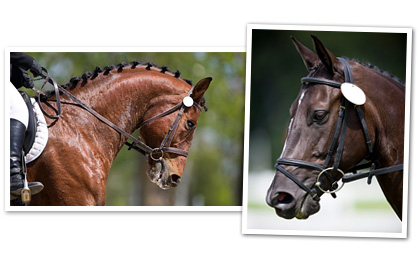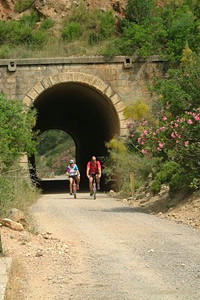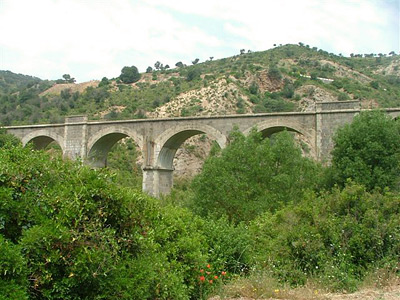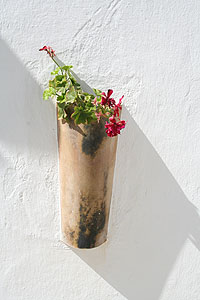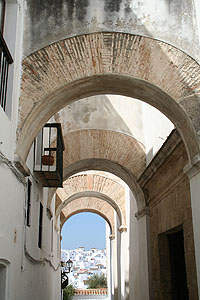Easter in Vejer is undoubtedly a magical time – firstly, the average daily temperature is an extremely agreeable 19 degrees Celsius (66 Fahrenheit), with cooling breezes rolling in from the Atlantic Ocean. Once more, the Andalusian climate provides a wonderful counterpoint to the incessant rain and storms that buffet northern Europe at this time of year, and it is small wonder that the region is so attractive to visitors during the holiday season.
Spain is still a staunchly Catholic country, and Holy Week – Semana Santa – is an integral part of the national calendar. It is a time for the local population to celebrate the end of Lent’s austerity, and reflect on the meaning of the festival.
In the immediate vicinity, this is strongly evident in the former Moorish strongholds of Seville (known locally as Sevilla), Cordoba and Granada. In fact, the Reconquista, or Catholic “reconquest” of Spain, culminated with the surrender of Granada in January 1492, to King Ferdinand, and his wife, Queen Isabela (also known as “the Catholic Monarchs” or los Reyes Catolicos). This event also has a festival dedicated to it – Moros y Cristianos – but this is a story for another day!
In Seville, also the capital of Andalusia, the celebrations are known throughout the world for their splendour, and feature a wide variety of events. Foremost amongst these are the main processions (59 in 2007, with some lasting up to 14 hours!) of the pasos and penitentes through the streets of the city. The former are floats of incredibly-detailed wooden sculptures depicting scenes from the Passion, and a large number of these are many hundreds of years old. The latter are members of various religious brotherhoods, dressed in their hallmark robes and conical masks. No matter what your take on religion may be, the incredible spectacle of Easter week in Andalusia simply cannot be ignored, with all its passion, colour and rich symbolism.
Two weeks after Easter sees the beginning of the Feria in Seville – The Spring Fair – this is an unmissable paean to all things Andalusian, and first occurred in 1847 as a livestock show for local farmers. Over the years, it has evolved to widen its scope considerably, and today you can see everything from stunning equestrian displays and parades – made up of the finest local horses and their riders, all dressed to the nines – to impromptu performances of the flamenco-inspired folk music that is so synonymous with the city; the Sevillanas, which are usually accompanied by dancers wearing brightly-coloured traditional costumes.
No visit to the fair would be complete without taking in some of the casetas, the temporary marquees set up along the banks of the Guadalquivir river to provide a focal point for proceedings. Inside them can be found everything from local food (with an emphasis on tapas) and plenty of drink (including Sherry and Manzanilla wine), to live music and dancing. The party goes on until seven most mornings, so some stamina can be required if you want to make it to dawn!
Back in Vejer, things are a bit more laid back when compared to the buzz of the cities – but locals still take the time to observe the Holy Week just like everywhere else in Spain.
One of the main events is the encierro – the bull run, where local breeders (ganaderos) are called in to let loose their young bulls in the streets, ready for all comers to run with them. Needless to say, this is NOT for the faint-hearted, and if you don’t want to take any risks it should be possible to find an out-of-the-way vantage point!
The tradition most probably has its roots in ancient Crete, where Minoan men would leap over bulls to prove their bravery – today, it forms part of the pantheon of tauromaquia – the art of bullfighting, and takes place throughout Spain, and as far north as the Camargue in southern France, with Pamplona as its spiritual home.
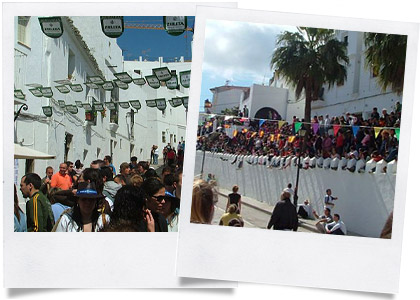
Some visitors to the region may find this kind of event unappealing, but much like the Catholicism, this is part of the Spanish way of life that shows no signs of abating in the near future, and it is not our intent to pass judgement on it either way, but rather prefer that our readers arrived at their own conclusions.
Easter is certainly a fascinating time to visit Andalusia, and Vejer de la Frontera is well-placed to provide a base from which to explore the region. The benign climate gives those interested in beach and water-based activities, such as the excellent surfing and windsurfing that can be had locally, an ideal warm-up (pun intended!) before the long summer months.
With the majority of rainfall having taken place over the winter period, the area is still green and lush, and offers an enormous diversity of cultural highlights to take in.
If you are looking to visit Seville at Easter, accommodation can be notoriously hard to find, and highly expensive in the rare occasions it does become available. We’d therefore recommend staying on the Costa de la Luz, and we have a fine, large house to rent in Vejer available at your disposal.
Why not visit us, and find out why a holiday in Vejer can provide so much more than the standard issue beach vacation.
